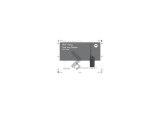RADIO OVERVIEW
9
Monitoring a Channel
For CLP1010 single-channel models
• To activate, press and hold the Menu button.
• To deactivate, press and hold the Menu button
again.
For CLP1040 multi-channel models
• To activate, press the Menu button to navigate to
Monitor mode.
• When Monitor is OFF, you will hear the voice
prompt: “Monitor” – “To activate” – “press +/-”.
• Press either “+/-“ button to activate the Monitor;
press either “+/-“ button again to deactivate.
• When Monitor is ON, you will hear static if no
activity is present or audio if channel activity is
present.
• To engage the Monitor mode, enable Monitor via
the menu and let the menu time out.
• To deactivate, press PTT during Monitor Menu
mode.
Scanning (*)
(*) For CLP1040 multi-channel models only
You can scan up to 4 channels. When the radio
detects activity, it stops scanning and locks in on
the active channel. This allows you to talk and
listen to the person transmitting without changing
channels.
• Press the Menu button to navigate to Scan mode.
• When Scan is OFF, you will hear the voice
prompt: “Scan” – “To activate” – “press +/-”.
• Press either “+/-“ button to activate the Scan;
press either “+/-“ button again to deactivate.
• When Scan is on, you will hear the voice prompt:
“Scan” – “To deactivate” – “press +/-” button.
Sending Call Tone (enabled through CPS)
(*) For CLP1040 multi-channel models only
• Press the Menu button to navigate to Call Tone.
• Press either “+/-“ button to transmit selected Call
Tone.
Note: There are 4 Call Tones available.






















